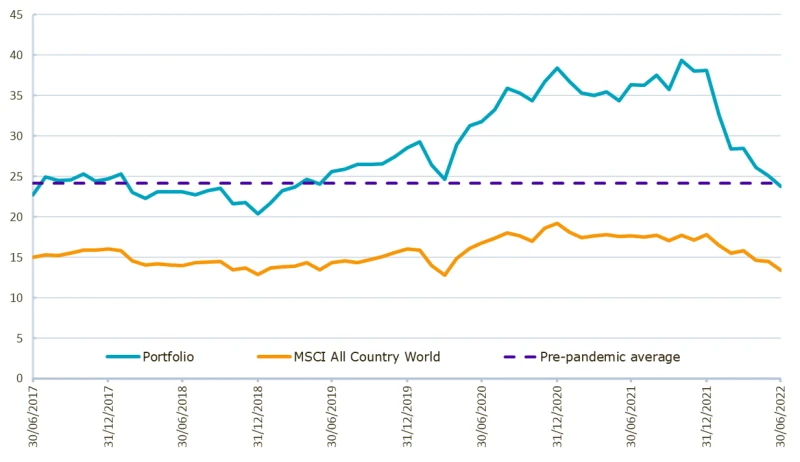More recently fears of an impending recession wreaked havoc on global stock markets overall, and previous strongholds like energy and commodities stocks have also succumbed to the increasing downward pressure. While this has clearly pressured absolute returns further, it does seem that growth stocks have started to do better from a relative perspective.
Perfect storm
We were probably due a market correction, although we’ll immediately acknowledge that the timing, speed and magnitude has taken even us by surprise. With hindsight of course all the signs were there, as we all witnessed a number of excesses that were indicative of a market peak.
However, something like a perfect storm made this excessive risk-taking happen. First, in their response to the pandemic outbreak, the Federal Reserve announced an emergency rate cut, lowering interest rates to near zero, and launched a massive quantitative easing program. Even though interest rates were already very low, the actions led investors to believe that central banks around the world would have a ‘whatever it takes’ approach to protect the economy.
As a result, the stock market boomed and in the case of the S&P 500, by August 2020 the full year-to-date decline had already been erased. Led by digitally exposed large-cap growth stocks, Apple (+81% in 2020) and Amazon (+76%) in particular, the bull market gained steam and investor sentiment rose rapidly.
Interest rates hurt
When markets turn, investors generally find out that a lot of money has been invested in unproductive or loss-making ventures. This time the catalyst for the shift in sentiment was rising levels of inflation and, subsequently, expectations of markedly higher interest rates.
Growth stocks, companies with above-average growth expectations, bore the brunt of the losses as these tend to trade at premium multiples of current earnings with investors paying up for the longer-term earnings potential. Growth stocks have been much more vulnerable to the increase in long-term interest rates as this impacts the rate at which future profits are discounted.
We are convinced that the majority of the valuation correction is behind us as the overall valuation of the portfolio is now more in line with the historical pre-pandemic average. At the end of the June, the forward P/E multiple of our portfolio was 23.7x with an estimated three-to-five year earnings growth of roughly 19%. The pre-pandemic average multiple of our portfolio (using data up to 31/12/2019) was actually 24.2x (see graph below).
Figure 3 | The valuation (measured by next year’s price-to-earnings ratio) of our portfolio versus the market

When times are tough
When times are tough and the portfolio is underperforming the market by a wide margin, as has been the case over the past twelve months, it makes sense to take a step back and look at the underlying fundamentals of the selected long-term trends. In this case, we returned to the first principles of trends investing to check whether our original assumptions are still valid.
As a reminder, trends investing strives to benefit from profound changes in society. These include technology-related changes, policy-driven change (regulations), and sociocultural and demographically driven change. Structural changes generally make it difficult for incumbent companies to stay in control of their market positions.
However, challenger firms or up-and-coming business ecosystems are often able to capitalize on these changes in order to enter existing markets or establish new ones. These moves are reflected in constantly shifting profit pools. Anticipating and taking advantage of these shifts is our main objective.
Long-term trends still very much alive
Another benefit of a trends approach is that it typically means abandoning rigid regional or sector classifications that often provide little added value in terms of evaluating the growth potential of companies. Trends usually span multiple regions and sectors. Looking for consistent exposure to a particular trend ensures the portfolio is structurally geared towards higher growth and economic value creation. The forward-looking nature of trends investing forms a sharp contrast to widely used benchmark-based frameworks that rely heavily on conditions in the present.
In the specific case of Global Consumer Trends the three long-term trends (digital transformation of consumption, the rise of the middle class in emerging markets, increased consumer attention on health & wellbeing) are still as valid as they were last year. For example, we think it’s highly unlikely that the shift towards digital payments will come to a standstill just because interest rates are rising.
However, given the increased economic and geopolitical uncertainty (high inflation, interest rate increases, oil prices at USD 120 a barrel, Russia’s war in Ukraine and so on) investors have significantly shortened their investment horizon. While that has led to a meaningful contraction in valuations in the first half of the year, it certainly hasn’t changed the longer-term validity of the selected themes.

